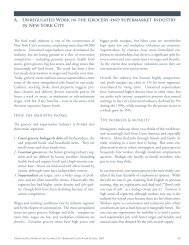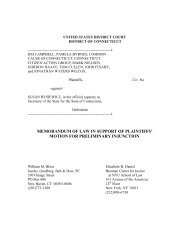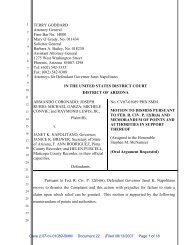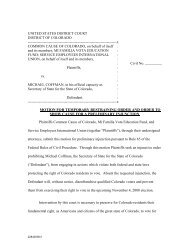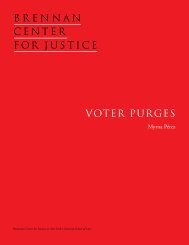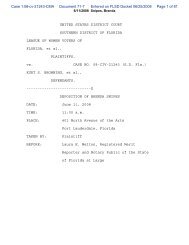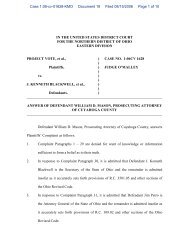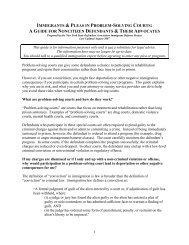Motion to Dismiss Case - Brennan Center for Justice
Motion to Dismiss Case - Brennan Center for Justice
Motion to Dismiss Case - Brennan Center for Justice
You also want an ePaper? Increase the reach of your titles
YUMPU automatically turns print PDFs into web optimized ePapers that Google loves.
<strong>Case</strong> 2:07-cv-01089-SMM Document 48 Filed 01/22/08 Page 14 of 15<br />
1<br />
2<br />
3<br />
4<br />
5<br />
6<br />
7<br />
8<br />
9<br />
10<br />
11<br />
12<br />
13<br />
14<br />
15<br />
16<br />
17<br />
18<br />
19<br />
20<br />
21<br />
22<br />
23<br />
24<br />
25<br />
26<br />
27<br />
28<br />
subjects. (Cf. Defs.’ Resp. at 25.) Assuming that § 2 and the Reconstruction and<br />
Readmission Acts address the same subject, a plain reading of § 2 “gives effect <strong>to</strong> both”<br />
provisions, as is the duty of the courts. Mor<strong>to</strong>n v. Mancari, 417 U.S. 535, 551 (1974).<br />
Plaintiffs provide no case law <strong>to</strong> contradict this conclusion, and other decisions<br />
addressing this issue further support a plain reading of “other crime.” The Cali<strong>for</strong>nia<br />
scheme upheld in Richardson disenfranchised persons convicted of “infamous crimes” or<br />
“a felony.” 418 U.S. at 27-30. This resulted in the disenfranchisement of a person<br />
convicted of drug possession, a crime which Plaintiffs allege was not a felony at common<br />
law. Id. at 32; Compl. 43. This prompted another district court <strong>to</strong> note, in considering a<br />
distinction between common law and non-common law felonies, “the Supreme Court,<br />
however, apparently gave no import <strong>to</strong> this distinction, and this court shall do the same.”<br />
Perry v. Beamer, 933 F. Supp. 556, 559-60 (E.D. Va. 1996) (granting motion <strong>to</strong> dismiss).<br />
Yet another court observed that “as the common law developed the meaning of the word<br />
‘felony’ changed.” Merritt v. Jones, 533 S.W.2d 497, 501 (Ark. 1976) (declining <strong>to</strong> read<br />
“felony at common law” in<strong>to</strong> the word “felonies” as used in disenfranchisement law).<br />
Based on the <strong>for</strong>egoing, the Court finds the phrase “other crime” is not limited <strong>to</strong><br />
felonies at common law. There<strong>for</strong>e Count Five fails <strong>to</strong> state a claim <strong>for</strong> relief under the<br />
Equal Protection Clause. Plaintiffs do not assert a claim under the Arizona Constitution<br />
independent of their interpretation of “other crime.” The Complaint alleges that the<br />
following language from Article 7, §2(C) has remained unchanged since the original<br />
Arizona constitution: “. . . nor shall any person convicted of treason or felony, be<br />
qualified <strong>to</strong> vote at any election unless res<strong>to</strong>red <strong>to</strong> civil rights.” (Compl. 45-46.) As<br />
Counts Six and Seven require interpreting “other crime” as “felonies at common law,”<br />
they also fail. (See Pls.’ Resp. at 29-30.) Defendants’ motion <strong>to</strong> dismiss Counts Five<br />
through Seven will be granted.<br />
//<br />
//<br />
- 14 -



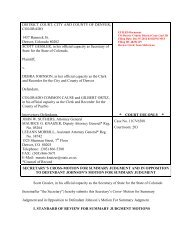
![Download the Letter [PDF] - Brennan Center for Justice](https://img.yumpu.com/50139248/1/190x245/download-the-letter-pdf-brennan-center-for-justice.jpg?quality=85)
